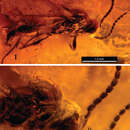en
names in breadcrumbs


Proctotrupidae is a family of wasps in the superfamily Proctotrupoidea of the order Hymenoptera. There are about 400 species in more than 30 genera in Proctotrupidae, found throughout most of the world.[2][1]
Proctotrupidae are small parasitoid wasps, using beetle larvae and fungus gnats as hosts. They typically have a body length of 5 to 8 mm, but species may range from 3 to 15 mm.[2]
Proctotrupidae is a family of wasps in the superfamily Proctotrupoidea of the order Hymenoptera. There are about 400 species in more than 30 genera in Proctotrupidae, found throughout most of the world.
Proctotrupidae are small parasitoid wasps, using beetle larvae and fungus gnats as hosts. They typically have a body length of 5 to 8 mm, but species may range from 3 to 15 mm.